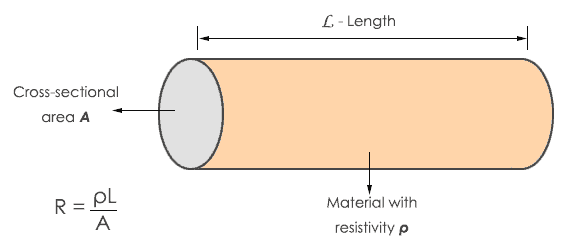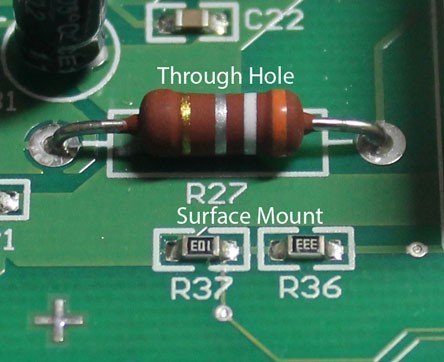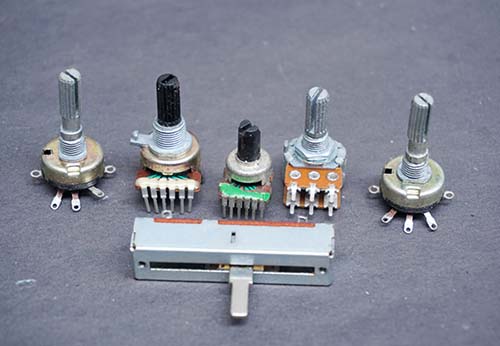Resistor color code indicates that a series of colored bands are painted on the resistor and most of the manufacturers identify their resistance value by means of a color code. There are various values of resistors available from some ohms to millions of ohms. It is not possible to have each and every value of resistor like 1Ω, 2Ω, 3Ω, and so they are in tens or hundreds or thousands. To overcome this, resistor color coding is introduced.
On every pinned (through hole) resistor, there are colored bands which denote the value of resistance in the resistor. Almost all resistors (pinned) with a power rating of up to 1 watt are marked with color bands. The coding of color is defined in the international standard 1EC60062. And also, the entire body of the resistor is colored; there are one or more colors on the ends of the resistors (called as tip colors) and lastly, there is a spot of paint on the body.
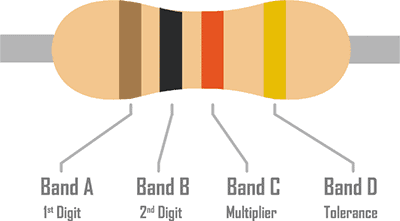
The colored bands on the resistors denote the value of resistance in resistor, tolerance and sometimes temperature coefficient. The number of colored bands can be from 3 to 6. To read colored bands on the resistor, we need to follow this color code chart.
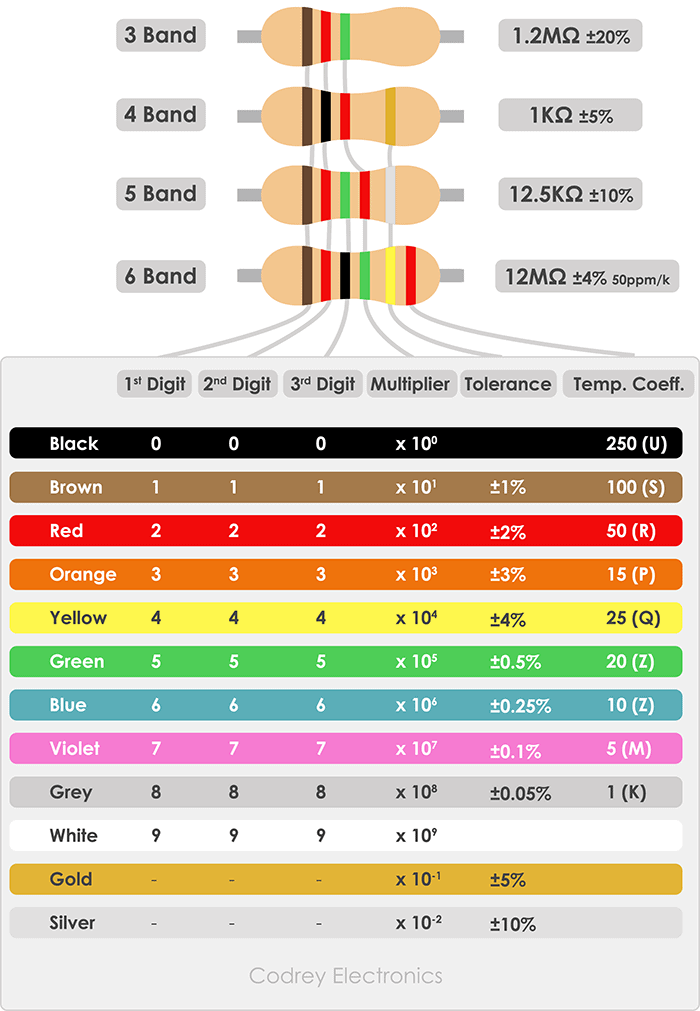
Before reading the resistor color codes, we need to first figure out from which band to start with. The tolerance band is situated with some gap from the other 2-3 bands so we get the idea from where to start with. Also, it is advisable to read the datasheet of the manufacturer to get the better idea of how to calculate resistance value from their color code.
Resistance Tolerance
Tolerance is the percentage of error in the value of resistance. Tolerance is how much we can expect a resistor’s actual measurement. If the tolerance is 5%, it means you can expect 5% change in the value of resistance. If the tolerance is less than 2% in a resistor, this type of resistors is known as precision resistors.
Note: If no tolerance band is given, then the tolerance should be taken as ±20%.
The sixth band is of shows the temperature coefficient of the resistor. The temperature coefficient is the change in resistance per one Kelvin change in temperature. If the temperature changes by 1 Kelvin and the sixth band is black, then there will be the change of 250 parts per million in resistors. This band is also found in high precision resistors.
Color Bands Representation
The first two color bands in a resistor denote resistance value (represented in ohms). To determine the standard resistance values, power ratings, the temperature coefficient of resistance and tolerance the resistors are grouped as 3 bands, 4 bands, 5 bands and 6 bands.
Three Band Resistor
Some resistors have only three bands. They come under 20% tolerance resistors. The three band resistance doesn’t require 4th band as they don’t have tolerance band. In the three bands first color indicates 1st digit, the second color indicates 2nd digit, the third color indicates 3rd digit.

For example, a resistor with 3 bands in the above figure has Orange, Red, and Black colors. The resistance of this 3 band resistor is calculated as:
| Band | Purpose |
|---|---|
| 1 | First significant digit |
| 2 | Second significant digit |
| 3 | Multiplier of power of 10 |
1st Band – Orange (3)
2nd Band – Red (2)
3rd Band – Black (1)
So, the three band resistor value is 32 multiplied with one which is equal to 32Ω ±20%.
Four Band Resistor

The four band resistor indicates the first digit for the 1st band, second digit for the 2nd band, third digit for 3rd band (multiplier or power of 10) and the fourth digit for 4th band represent tolerance of ±5%, ±10%, and ±20%.
To calculate the resistance of four band resistor, the below color code chart is considered. The resistance value is calculated as:
| Band | Purpose |
|---|---|
| 1 | First significant digit |
| 2 | Second significant digit |
| 3 | Multiplier of power of 10 |
| 4 | Tolerance |
1st Band – Red (2)
2nd Band – Orange (3)
3rd Band – Green (105)
4th Band – Gold (±5%)
So, the resistance is 23 multiplied by 100000 which is equal to 2.3 MΩ ±5%.
Five Band Resistor

These are the special type of resistors with five bands. Other than, one or two coloured bands five band resistor has extra third digit value. This band is present in high precision resistors.
| Band | Purpose |
|---|---|
| 1 | First significant digit |
| 2 | Second significant digit |
| 3 | Third significant digit |
| 4 | Multiplier of power of 10 |
| 5 | Tolerance |
To find the resistance of a five band resistor, here is the calculation.
1st Band – Red (2)
2nd Band – Green (5)
3rd Band – Orange (3)
4th Band – Yellow (104)
5th Band – Violet (±0.1%)
So, the resistance is 253 multiplied with 10,000 which is equal to 2.53 MΩ ±0.1%. This means for a value of 2.53 MΩ, the resistance value varies from 2529999.9 ohms to 2530000.1 ohms.
Six Band Resistor

The value of resistance changes with temperature. The rise or fall in temperature may affect the tolerance. To avoid this six band resistor is used. The six band color indicates the amount of resistance value that will change with respect to temperature. The temperature coefficient of resistance is indicated in ppm/°C.
Band Purpose
1 First significant digit
2 Second significant digit
3 Third significant digit
4 Multiplier of power of 10
5 Tolerance
6 Temperature coefficient of resistance
Here is the temperature coefficient calculation of 6 band resistor for 2.3 MΩ resistor at 40°C.
1st Band – Brown (1)
2nd Band – Black (0)
3rd Band – Black (0)
4th Band – Brown (101)
5th Band – Green (±0.5%)
6th Band – Red (50 ppm/ °C)
Formula: Percentage change in ohms = ppm × temperature (°C) /Resistance (Ω) = 50 × 40 /1000 = 2
So, the resistance is 100 multiplied by 10 which is equal to 1KΩ ±0.5% with 50 ppm/°C. This indicates that for 50 ppm, the resistance of 2 ohms will change at 40°C.
How to read Resistor Color Code?
The first two bands of resistor show the resistance value of the resistor. And the third band is a multiplier. If the colored bands on the resistor are green, blue and red. Then value of resistor is 56 × 100 = 5600Ω i.e. 5.6kΩ.
As I said, some resistors have the fourth band on them. The fourth band shows the tolerance and mostly seen in high precision resistors. If the colored bands are green, blue, red and brown, then the value of the resistor would be 56 × 100 = 5600Ω 1% i.e. 5.6kΩ ±1%.
Resistors with high precision also have an extra band for the third digit of their value. So if there are 5 bands on resistance and colored bands are brown, black, black and red then the value will be 100 ×100 = 10000Ω = 10kΩ of resistance in the resistor and the fifth band is tolerance. The tolerance band has increased space between 3 or 4 bands. Now if the last band has a brown color, then tolerance would be 1% and the resistor value will be 10kΩ ±1%.
Exceptions
Some resistors have a special case of color bands. They are zero ohm resistors which are having a single color band on the body. In some cases, resistors used in military applications have a 5th color band to show the failure rate of the resistor. Some common issues while decoding the resistor is color blindness. The value of the resistor is not exact in some scenarios due to damage or aging factor.
Thus in this way, we can figure out the value of resistors from their color code. However, by measuring using a multimeter or ammeter, we can get the exact measurement of resistance in the resistor. This method is widely used in assembling industries where workers use their skills to identify the value of the resistor by color coding.

